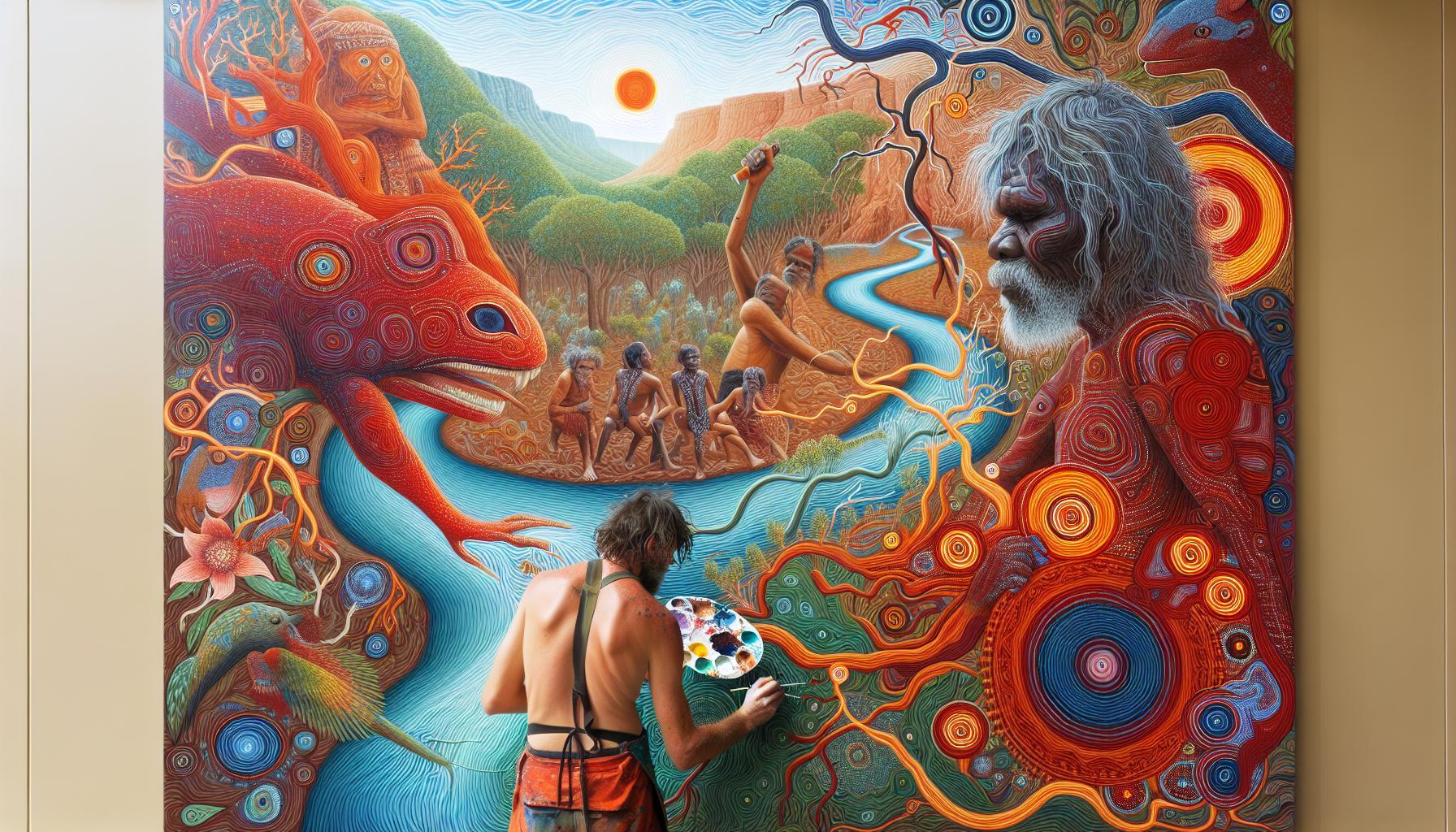Dreamtime art serves as a vibrant expression of Aboriginal culture, weaving together stories, beliefs, and the deep connection to the land. This unique art form reflects the spiritual and ancestral narratives that shape their identity, illustrating the Dreamtime—a time when ancestral beings created the world. Through intricate patterns and symbols, these artworks convey the values and traditions that have been passed down through generations. Each piece of Dreamtime art encapsulates significant elements of the Aboriginal belief system, from creation myths to moral lessons. It not only tells stories but also fosters a sense of community and belonging. By exploring the rich tapestry of Dreamtime art, one can gain insight into the profound relationship Aboriginal people have with their environment and the spiritual dimensions of their existence.
Dreamtime Art of the Aboriginals Depicts Which Aspects of Their Deep Belief System?
Dreamtime art serves as a powerful visual language for Aboriginal people, representing spiritual beliefs and ancestral connections. This art form captures narratives from the Dreamtime, a sacred period when ancestral beings shaped the Earth and established cultural norms. Each piece features distinct symbols and patterns, illustrating creation stories, moral teachings, and significant events in Aboriginal history.
Dreamtime art often incorporates motifs like animals, plants, and celestial bodies, each symbol carrying specific meanings tied to cultural legends. For instance, the serpent represents water and fertility, while certain plants signify healing and nourishment. These elements reveal the interconnectedness of life and the environment in Aboriginal thought.
Additionally, Dreamtime art reinforces communal identity, fostering a sense of belonging among Aboriginal communities. Collaborative practices in creating these artworks strengthen social ties and preserve cultural knowledge. As such, Dreamtime art acts not only as an artistic expression but also as a vital medium for transmitting beliefs and maintaining cultural heritage.
Significance of Dreamtime in Aboriginal Culture
Dreamtime holds profound significance in Aboriginal culture, representing the foundation of their belief system. It encompasses creation narratives, spiritual connections, and the moral framework guiding community life.
Connection to Ancestral Beings
Aboriginal art vividly portrays ancestral beings who created the world during the Dreamtime. These beings embody various elements in nature, including mountains, rivers, and animals. Each artwork acts as a reminder of these relationships, emphasizing the continuity between the past and present. The presence of ancestral figures reinforces the community’s bond with their land and heritage, serving as a guide for behavior and spiritual practice.
Symbolism in Dreamtime Stories
Symbolism permeates every aspect of Dreamtime stories, with each symbol possessing specific meanings rooted in cultural legends. For instance, the kangaroo symbolizes strength and agility, while the owl represents wisdom and transition. Visual elements, including patterns and motifs, narrate stories that teach important life lessons, reinforce cultural values, and express spiritual beliefs. The intricate design fosters a deeper understanding of the interconnectedness of all life, reflecting the holistic worldview central to Aboriginal spirituality.
Aspects of Belief System Depicted in Art
Dreamtime art intricately reflects various aspects of the Aboriginal belief system. Through vivid symbols and narratives, it encapsulates creation myths, spiritual connections to the land, and societal structure.
Creation Myths
Creation myths play a pivotal role in Dreamtime art. These stories convey how ancestral beings shaped the world and its inhabitants. For instance, the Rainbow Serpent embodies the essence of creation, symbolizing water and life. Paintings often depict significant events from these myths, illustrating the birth of landscapes and the emergence of species. Each creation story serves not just as a cultural narrative but as a moral framework guiding behavior and understanding of the cosmos.
Spiritual Connections to the Land
Dreamtime art emphasizes the deep spiritual connections Aboriginal people have with their land. Each artwork embodies elements of nature, such as rivers, mountains, and animals, representing sacred sites and ancestral trails. For example, representations of emus or kangaroos signify more than mere animals; they denote ancestral heritage and spiritual essence embedded in the natural world. This close relationship fosters respect and stewardship, as the land is viewed as a living entity—integral to existence and spirituality.
Social Structures and Relationships
Social structures and relationships also manifest in Dreamtime art. Artwork often features depictions of community gatherings, rituals, and ceremonies, highlighting the communal aspects of Aboriginal life. Symbols illustrating totemic relationships clarify lineage and responsibilities within clans. For instance, specific animal motifs signify familial ties and communal roles, creating a visual narrative of interconnectedness among individuals. This representation reinforces the bonds that unite the community, ensuring cultural continuity and shared values.
Contemporary Relevance of Dreamtime Art
Dreamtime art maintains significant relevance in today’s society, serving as a bridge between traditional Aboriginal beliefs and contemporary expressions. This art form not only preserves cultural heritage but also inspires modern interpretations that resonate with broader audiences.
Preservation of Heritage
Dreamtime art plays a crucial role in preserving Aboriginal heritage. Each artwork carries stories passed down through generations, ensuring the transmission of cultural knowledge. Artworks depict symbols and motifs linked to specific ancestral narratives, contributing to the continuity of community identity.
Organizations and artists actively promote workshops and exhibitions, aiming to educate non-Aboriginal audiences about the importance of Dreamtime art. These efforts stress the need to honor and respect Aboriginal traditions, thereby securing a place for their rich history in the modern cultural landscape. Additionally, community-led initiatives focus on integrating traditional practices with contemporary techniques, ensuring ongoing engagement with the art form while maintaining fidelity to its origins.
Impact on Modern Art
Dreamtime art significantly influences modern art movements, with contemporary artists drawing inspiration from its unique visual language. Artists globally incorporate Aboriginal symbols and storytelling techniques, reflecting a growing appreciation for Indigenous perspectives.
Exhibitions and collaborations highlight this impact, showcasing the dynamism of Dreamtime art within diverse artistic practices. The integration of these techniques encourages dialogue about cultural identity and the significance of landscape, spirituality, and community in contemporary art forms. As a result, Dreamtime art not only celebrates Aboriginal heritage but also enriches the broader art world by introducing fresh narratives and visual elements. Dreamtime art stands as a powerful testament to the rich tapestry of Aboriginal belief systems. Through intricate symbols and vibrant narratives, it encapsulates creation myths and spiritual connections that define their culture. This art form not only preserves ancestral knowledge but also reinforces community bonds, showcasing the deep respect Aboriginal people have for their land and heritage. In a modern context, Dreamtime art continues to thrive, bridging traditional beliefs with contemporary expressions. Its influence extends beyond Aboriginal communities, inviting a broader audience to appreciate and understand the profound significance of these artworks. By celebrating Dreamtime art, one honors the enduring legacy of Aboriginal culture and its vital role in shaping identity and spirituality.


